
Swainsona is a genus of about 85 species of flowering plants in the family Fabaceae, and is endemic to Australia. Plants in this genus are herbs or subshrubs with imparipinnate leaves and usually purple flowers similar to others in the family.

Swainsona galegifolia commonly known as smooth Darling pea, is a species of flowering plant in the family Fabaceae and is endemic to Australia. It is a small shrub with greyish-green leaves and flowers in white, red, pink, purple, yellow or orange.

Swainsona greyana, commonly known as Darling Pea or Hairy Darling Pea, is a shrubby perennial in the family Fabaceae that is native to Australia. It grows to 1.5 metres high, has hairy stems and pinnate leaves that are 10 to 15 cm long. Racemes of 12 to 20 pea flowers are produced from September to March in the species' native range. These have white, pink or purple corollas. The pods that follow are elliptic in shape and 30 to 50 mm long.

Swainsona behriana, commonly known as Behr's swainsona, is a species of flowering plant in the family Fabaceae and is endemic to south-eastern continental Australia. It is a prostrate or low-growing perennial herb with imparipinnate leaves usually with 9 to 13 narrowly elliptic to egg-shaped leaflets with the narrower end towards the base, and racemes of 2 to 7 purple flowers.

Leptospermum macrocarpum is a species of shrub that is endemic to the Blue Mountains in New South Wales. It has thin, hard, sometimes gnarled bark on the older stems, broadly elliptical leaves, relatively large white, pink or dark red flowers and large fruit.
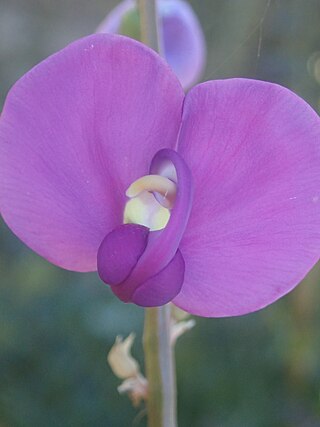
Swainsona procumbens is a plant in the pea family (Fabaceae) native to Australia and found in New South Wales, Victoria, Queensland and South Australia.
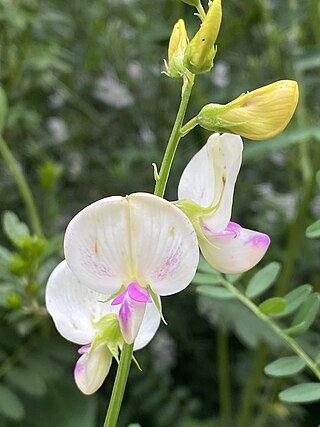
Swainsona sejuncta is a species of flowering plant in the family Fabaceae. It has pea-shaped flowers in a variety of colours, pink, cream, orange and mauve from spring to summer and is endemic to Queensland.
Goodenia havilandii, commonly known as hill goodenia, is a species of flowering plant in the family Goodeniaceae and is endemic to the drier parts of southern Australia. It is a prostrate to ascending, short-lived herb with sticky leaves and racemes of yellowish flowers with a brown centre.

Pultenaea cinerascens is a species of flowering plant in the family Fabaceae and is endemic to central New South Wales. It is an erect to spreading shrub with narrow oblong to wedge-shaped leaves, and groups of yellow and red flowers.

Pimelea bracteata, is a species of flowering plant in the family Thymelaeaceae and is endemic to the south-west of New South Wales. It is a shrub with narrowly egg-shaped to elliptic leaves and pendulous, pale green heads of pale yellow flowers.

Swainsona maccullochiana, commonly known as Ashburton pea, is a species of flowering plant in the family Fabaceae. It is an upright annual with purple-reddish, pink or bluish pea-like flowers from spring to summer and is endemic to Western Australia.
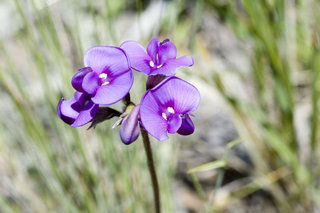
Swainsona sericea commonly known as silky Swainson-pea or silky pea, is a flowering plant in the family Fabaceae. It is a small perennial with greyish-green leaves, purple flowers and grows in New South Wales, Victoria and South Australia.
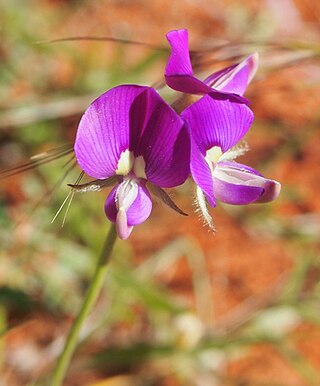
Swainsona phacoides commonly known as dwarf Swainson-pea or lilac Darling pea, is a flowering plant in the family Fabaceae. It is a small perennial herb, usually purple flowers and grows in all mainland states of Australia and the Northern Territory.

Swainsona swainsonioides commonly known as downy Swainson-pea or downy Darling pea,is a flowering plant in the family Fabaceae. It is a small perennial herb with purple flowers and grows in eastern states of Australia.
Goodia macrocarpa is a species of flowering plant in the family Fabaceae and is endemic to eastern Australia. It is a shrub with trifoliate leaves, the leaflets narrowly elliptic to elliptic, and bright yellow and red pea-like flowers.
Swainsona acuticarinata is a species of flowering plant in the family Fabaceae and is endemic to arid areas of central Australia. It is a prostrate perennial herb with imparipinnate leaves with 5 to 11 leaflets, and racemes of purple flowers.
Swainsona adenophylla, commonly known as violet swainson-pea or violet Darling pea, is a species of flowering plant in the family Fabaceae and is endemic to arid areas of central Australia. It is a slender, erect or spreading perennial herb with imparipinnate leaves with three to nine linear to narrowly egg-shaped leaflets, and racemes of pink or purplish flowers in racemes of ten to twenty.
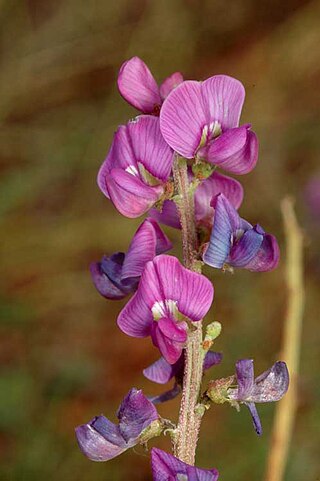
Swainsona affinis, commonly known as common poison pea, is a species of flowering plant in the family Fabaceae and is endemic to arid areas of inland Australia. It is a prostrate perennial herb with imparipinnate leaves with 7 to 25 broadly elliptic leaflets, and racemes of purple, pink, yellow or white flowers.

Swainsona beasleyana is a species of flowering plant in the family Fabaceae and is endemic to inland areas of Western Australia. It is a low-lying perennial herb with imparipinnate leaves usually with 15 to 19 egg-shaped leaflets with the narrower end towards the base, and racemes of 3 to 8 pale or dark purple flowers.

Swainsona brachycarpa, commonly known as slender swainson-pea, is a species of flowering plant in the family Fabaceae and is endemic to eastern Australia. It is a prostrate or ascending perennial herb with imparipinnate leaves usually with 9 to 13 egg-shaped to narrowly elliptic or egg-shaped leaflets, and racemes of up to 12 white, purple or dark red flowers.















